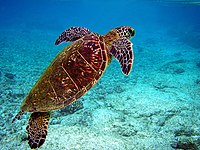
Photo from wikipedia
The number of nesting leatherback turtles (Dermochelys coriacea) in the eastern Pacific Ocean has declined dramatically since the late 1980s. This decline has been attributed to egg poaching and interactions… Click to show full abstract
The number of nesting leatherback turtles (Dermochelys coriacea) in the eastern Pacific Ocean has declined dramatically since the late 1980s. This decline has been attributed to egg poaching and interactions with fisheries. However, it is not clear how much of the decline should also be ascribed to variability in the physical characteristics of the ocean. We used data on individually marked turtles that nest at Playa Grande, Costa Rica, to address whether climatic variability affects survival and inter-breeding interval. Because some turtles might nest undetected, we used capture-recapture models to model survival probability accounting for a detection failure. In addition, as the probability of reproduction is constrained by past nesting events, we formulated a new parameterization to estimate inter-breeding intervals and contrast hypotheses on the role of climatic covariates on reproductive frequency. Average annual survival for the period 1993-2011 was low (0.78) and varied over time ranging from 0.49 to 0.99 with a negative temporal trend mainly due to the high mortality values registered after 2004. Survival probability was not associated with the Multivariate ENSO Index of the South Pacific Ocean (MEI) but this index explained 24% of the temporal variability in the reproductive frequency. The probability of a turtle to permanently leave after the first encounter was 26%. This high proportion of transients might be associated with a high mortality cost of the first reproduction or with a long-distance nesting dispersal after the first nesting season. Although current data do not allow separating these two hypotheses, low encounter rate at other locations and high investment in reproduction, supports the first hypothesis. The low and variable annual survival probability has largely contributed to the decline of this leatherback population. The lack of correlation between survival probability and the most important climatic driver of oceanic processes in the Pacific discards a climate-related decline and point to anthropogenic sources of mortality as the main causes responsible for the observed population decline.
Journal Title: Ecology
Year Published: 2017
Link to full text (if available)
Share on Social Media: Sign Up to like & get
recommendations!